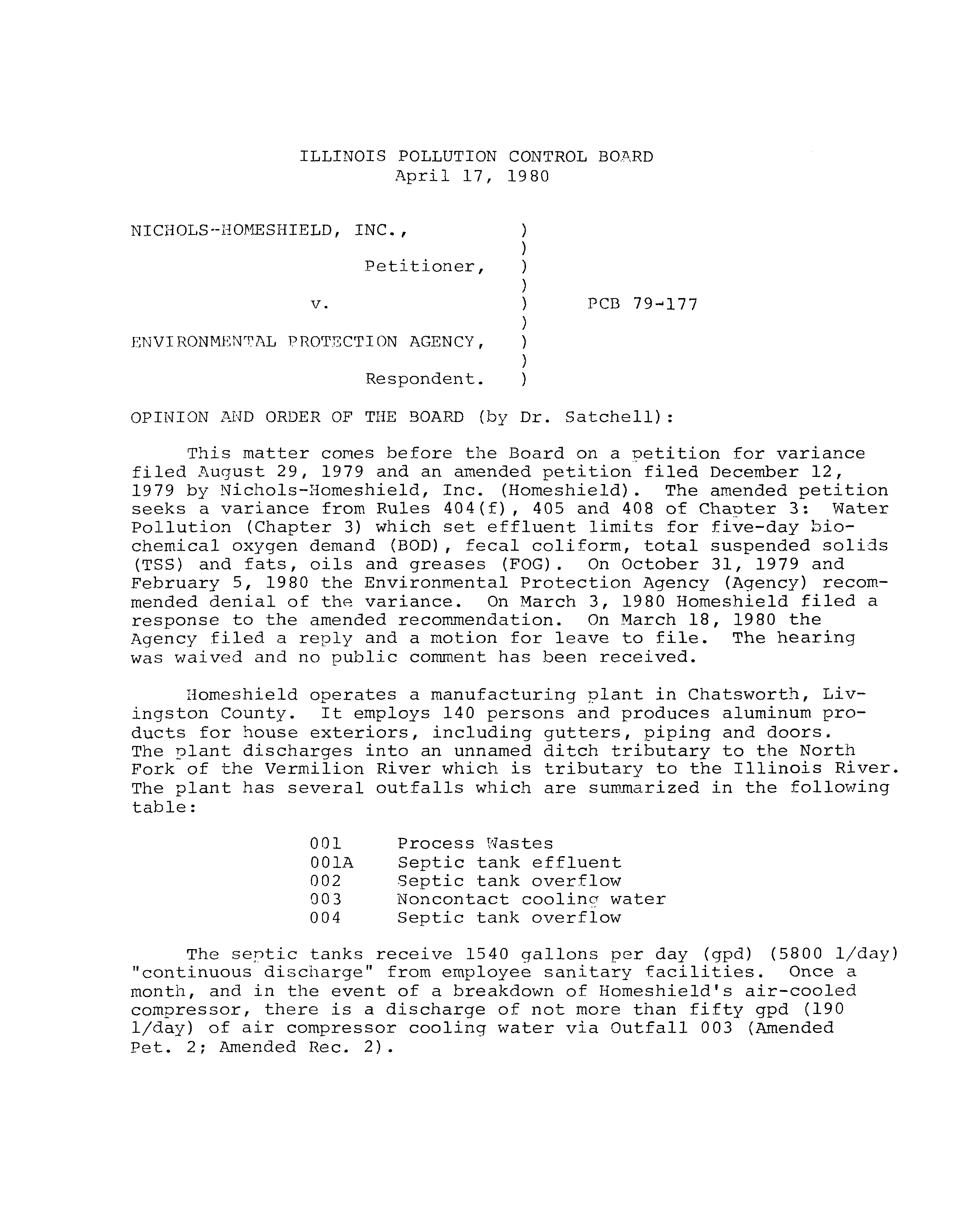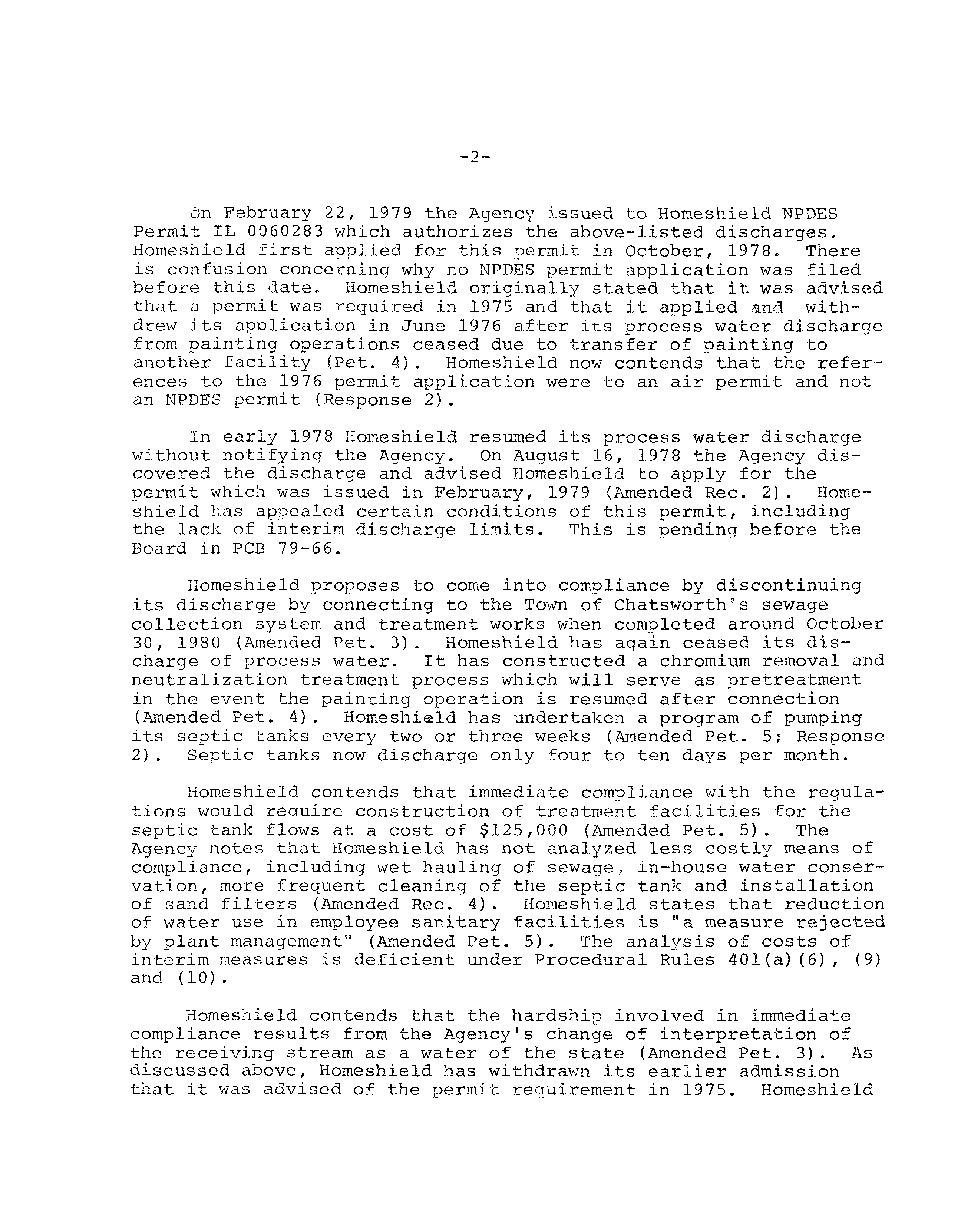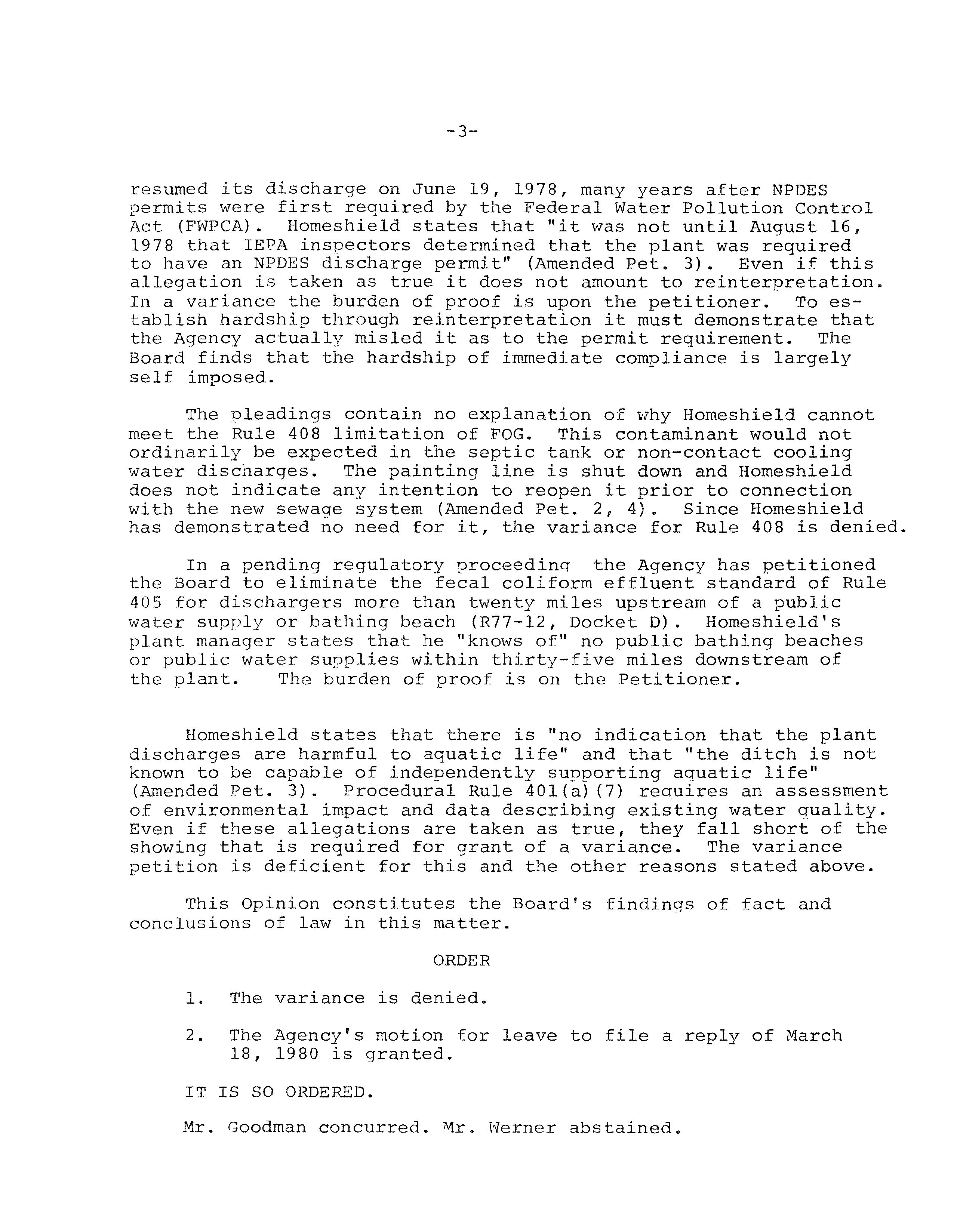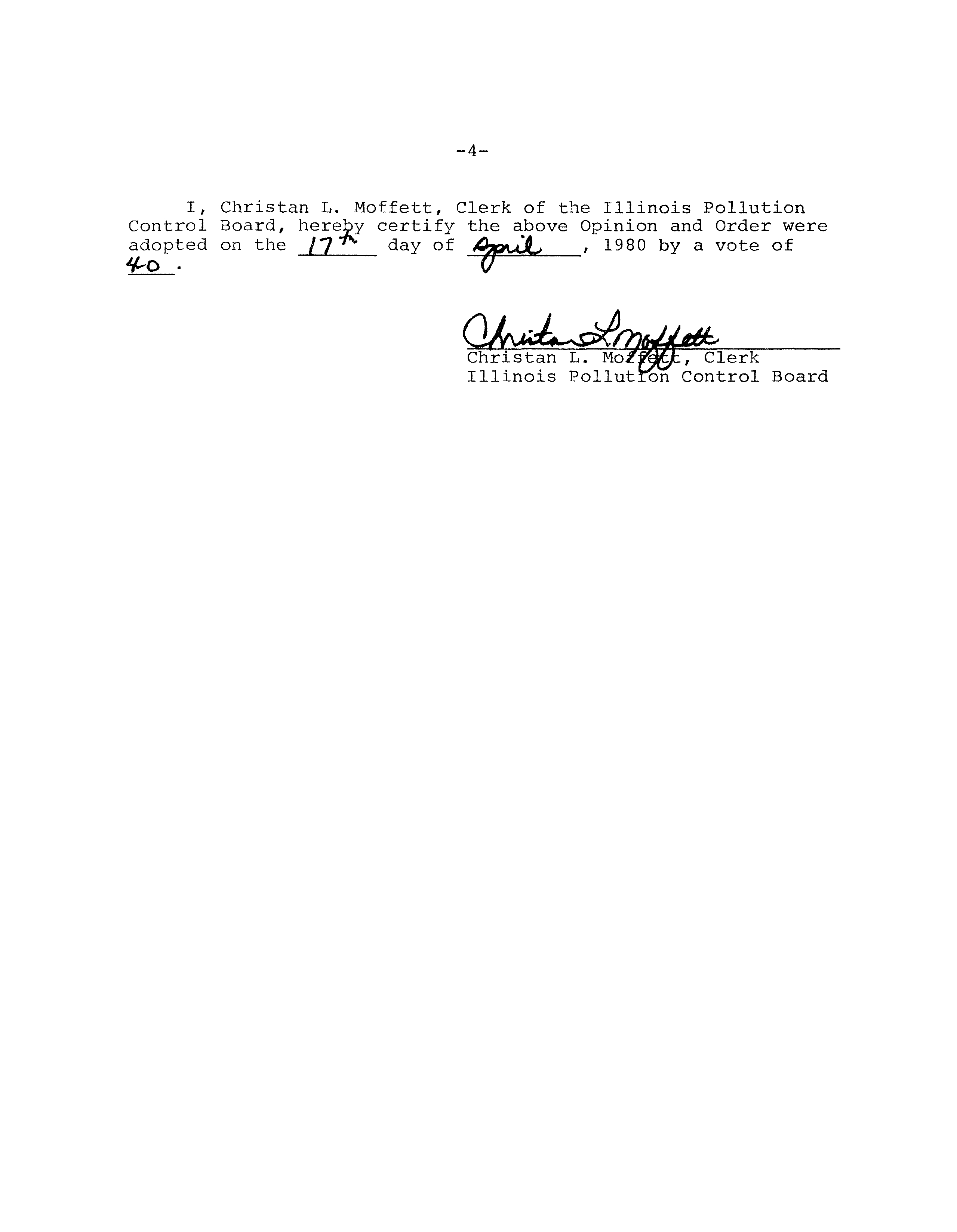ILLINOIS
POLLUTION
CONTROL
BOARD
April 17,
1980
NICHOLS--HOMESFIIELD,
INC.,
Petitioner,
V.
)
PCB
79-’177
ENVIRONMENTAL
PROTECTION
AGENCY,
)
Respondent.
OPINION
AND
ORDER OF
THE
BOARD
(by
Dr.
Satchell):
This matter comes before the Board on
a petition for variance
filed August 29,
1979 and an amended petition filed December 12,
1979 by Nichols—Homeshield,
Inc.
(Homeshield).
The amended petition
seeks
a variance from Rules
404(f),
405 and 408 of Chapter
3:
Water
Pollution
(Chapter
3) which set effluent limits for five-day
bio-
chemical oxygen demand
(BOD)
,
fecal coliform,
total suspended solids
(TSS)
and fats,
oils and greases
(FOG).
On October 31, 1979 and
February
5,
1980 the Environmental Protection Agency
(Agency) recom-
mended denial of the variance.
On March
3,
1980 Homeshield filed a
response
to the amended recommendation.
On March 18,
1980 the
Agency filed a reply and a motion for leave
to file.
The hearing
was waived and no public comment has been received.
Homeshield operates
a manufacturing plant
in Chatsworth, Liv-
ingston County.
It employs
140 persons and produces aluminum pro-
ducts for house exteriors,
including gutters, piping and doors.
The plant discharges into an unnamed ditch tributary to the North
Fork of the Vermilion River which
is tributary
to the Illinois River.
The plant has several outfalls which are summarized in the following
table:
001
Process Nastes
OOlA
Septic tank effluent
002
Septic tank overflow
003
Noncontact
coolinci water
004
Septic tank overflow
The septic tanks receive
1540 gallons per day
(gpd)
(5800
1/day)
“continuous discharge” from employee sanitary facilities.
Once a
month,
and in the event of a breakdown of Homeshield’s air-cooled
compressor,
there is a discharge of not more than fifty gpd
(190
1/day)
of air compressor cooling water via Outfall
003
(Amended
Pet.
2; Amended Rec,
2).
—2--
~n February 22,
1979 the Agency issued to Homeshield NPDES
Permit IL 0060283 which authorizes the above—listed discharges.
Homeshield
first applied for this oermit in October,
1978.
There
is confusion concerning why no NPDES permit application was filed
before
this date.
Homeshield originally stated that it was advised
that
a permit was required in 1975 and that it applied and
with-
drew its apulication in June 1976 after its process water discharge
from painting operations ceased due to transfer of painting to
another facility
(Pet.
4).
Homeshield now contends that the refer-
ences
to the 1976 permit application were to an air permit and not
an NPDES permit
(Response 2).
In early 1978 Homeshield resumed its process water discharge
without notifying the Agency.
On August
16,
1978 the Agency dis-
covered the discharge and advised Homeshield
to apply for the
permit which was issued in February,
1979
(Amended Rec.
2).
Home-
shield has appealed certain conditions of this permit,
including
the lack
of interim discharge limits.
This is pendinq before the
Board
in PCB 79-66.
Homeshield proposes to come into compliance by discontinuing
its discharge by connecting to the Town of Chatsworth~s sewage
collection system and treatment works when completed around October
30,
1980
(Amended Pet.
3).
Homeshield has again ceased its dis-
charge of process water.
It has constructed
a chromium removal and
neutralization treatment process which will serve
as pretreatment
in the event the painting operation is resumed after connection
(Amended Pet.
4).
Homeshi~1dhas undertaken
a program of pumping
its septic tanks every two or three weeks
(Amended Pet.
5; Response
2).
Septic tanks now discharge only four to ten days per month.
Homeshield contends that immediate compliance with the regula-
tions would require construction of treatment facilities for the
septic tank flows
at a cost of $125,000
(Amended Pet.
5).
The
Agency notes that Homeshield has not analyzed less costly means of
compliance,
including wet hauling of sewage, in—house water conser-
vation, more frequent cleaning of the septic tank and installation
of sand filters
(Amended Rec.
4).
Homeshield states that reduction
of water use in employee sanitary facilities
is “a measure rejected
by plant management”
(Amended Pet.
5).
The analysis of costs of
interim measures
is deficient under Procedural Rules
401(a) (6)
,
(9)
and
(10).
Homeshield contends that the hardship involved in immediate
compliance results from the Agency’s change of interpretation of
the receiving stream as
a water of the state
(Amended Pet.
3)
.
As
discussed above, Homeshield has withdrawn
its earlier admission
that it was advised of the permit renuirement in 1975.
Homeshield
—3—
resumed its discharge on June 19,
1978, many years
after NPDES
permits were first required by the Federal Water Pollution Control
Act
(FWPCA).
Homeshield states that “it was not until August
16,
1978 that TEPA inspectors determined that the plant was required
to have an NPDES discharge permit”
(Amended Pet.
3).
Even if this
allegation
is taken as true it does not amount to reinterpretation.
In
a variance the burden of proof is upon the petitioner.
To es-
tablish hardship through reinterpretation it must demonstrate that
the Agency actually misled it as to the permit requirement.
The
Board
finds that the hardship of immediate compliance
is largely
self imposed.
The pleadings
contain no explanation of why Homeshield cannot
meet the Rule 408 limitation of FOG.
This contaminant would not
ordinarily be expected in the septic tank or non-contact cooling
water discharges.
The painting line is
shut down and Homeshield
does not indicate any intention to reopen
it prior
to connection
with the new sewage system
(Amended Pet.
2,
4).
Since Homeshield
has demonstrated no need for it, the variance for Rule 408
is denied.
In
a pending regulatory proceedinci
the Agency has petitioned
the Board to eliminate the fecal coliform effluent standard of Rule
405 for dischargers more than twenty miles upstream of a public
water supply or bathing beach
(R77-l2, Docket
D)
.
Homeshield’s
plant manager states that he “knows of” no public bathing beaches
or public water supplies within thirty-five miles downstream
of
the plant.
The burden of proof is on the Petitioner.
Homeshield states that there
is “no indication that the plant
discharges
are harmful to aquatic
life” and that “the ditch
is not
known to be capable of independently suPporting aquatic
life”
(Amended Pet.
3).
Procedural Rule 401(a) (7)
reauires
an assessment
of environmental impact and data describing existing water quality.
Even if these allegations are taken as true,
they fall short of the
showing that
is required for grant of a variance.
The variance
petition
is deficient for this and the other reasons stated above.
This Opinion constitutes the Board’s
findings of fact and
conclusions
of law in this matter.
ORDER
1.
The variance
is denied.
2.
The Agency’s motion for leave to file a reply of March
18,
1980
is granted.
IT
IS SO ORDERED.
Mr. Goodman concurred. Mr. Werner abstained.
—4—
I,
Christan L.
Moffett,
Clerk of the Illinois Pollution
Control Board,
herel2y certify the above Opinion and Order were
adopted on the
/77
day of
_________,
1980 by a vote of
I~c-o.
Christan L. Mo!
,
Clerk
Illinois Pollut on Control Board




